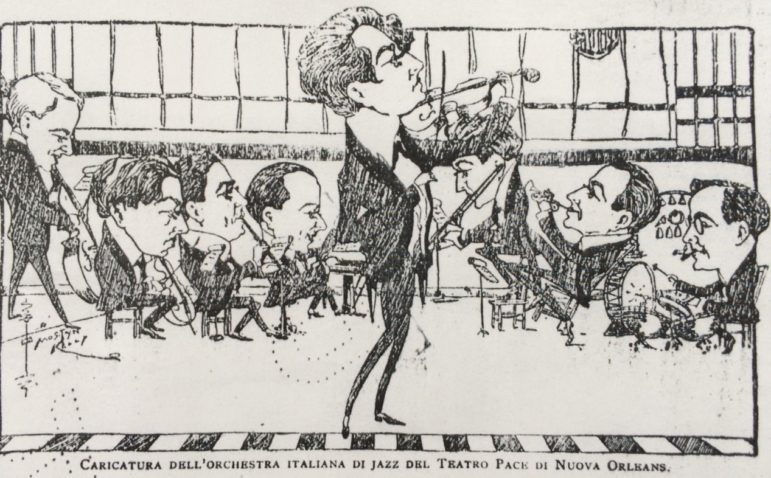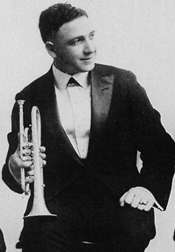
As genres go, New Orleans-style jazz is the quintessential musical hybrid, mixing everything from brass band marches and French quadrilles to beguine, ragtime and blues. There’s no disputing that the cross-fertilization was carried out under an innovative performance style that first took root in New Orleans in the hands of African-American musicians. But what accounted for the rapid spread of jazz — or “jass” — was the mesmerizing synthesis of its myriad musical characteristics by musicians of various ethnicities, not least of them Italian.
As jazz developed in New Orleans during the 1910s, listeners became captivated by its upbeat, syncopated energy, which in turn made it ripe for commercialization via the latest recording technologies. Jazz is rooted in the genius of Scott Joplin, Buddy Bolden and other African Americans, but its emergence as what would become the 20th century’s defining musical innovation occurred far from Basin Street. Indeed, rarely can the advent of a musical revolution so huge be traced as precisely to a single moment: Feb. 26, 1917.
On that date, a combo from New Orleans called the Original Dixieland Jazz Band, featuring Nick LaRocca on cornet, walked into a Victor recording studio in New York and cut the first commercial jazz recording. Side A featured a tune called “Dixieland Jass Band One-Step;” the B side was “Livery Stable Blues.”
Although countless musicians, both black and white, contributed to the development of jazz during the first two decades of the 20th century, LaRocca and the Original Dixieland Jazz Band stand out for their contribution to its rapid dissemination. LaRocca, an Italian American, was a fine cornet player — also a trumpeter and composer — but his greatest talent lay in self-promotion. He did not invent jazz, as he would later claim, but he was the first to realize the importance of recording it. Consequently, “Dixieland Jass Band One-Step” and “Livery Stable Blues” launched the jazz age with all its accouterments, from driving rhythms and flapper fashions to risqué dances and potent cocktails. By 1918 the band had sold over one million copies of its first gramophone disc – a truly astounding number for the time
The story of jazz in Italy begins, interestingly enough, with a description of the American music industry penned by an Italian diplomat named Chevalier Bruno Zuculin. Italian readers wanted to know more about the origins of jazz, and in August 1919 Zuculin published a somewhat glib, yet telling, description of the New Orleans jazz scene in La Lettura, a monthly illustrated supplement to Corriere della Sera, Italy’s most widely read newspaper at the time:
There are two categories of jazz bands: those that are mostly black, which perform in the hotels, restaurants, dance halls and social clubs; and those, often Italian, that play in the cinemas, in variety shows and in those numerous theaters where the most genuine theatrical product of North America flourishes, namely the entertaining productions called “Musical Comedies” or “Girls and Music Shows,” wherein the plot, if it exists at all, is of little importance to anyone, and the success of the performance is based primarily on the quality of the music and the beauty of the girls.
Zuculin was reporting directly from New Orleans, where he had been serving as Italy’s consul general for just over a year. He was the first to state, quite emphatically, that Italian immigrants played a role in the genesis of jazz in the United States, and it was this belief, perhaps more than anything else, that later drove many Italians to embrace the music as a “native” art form.
Zuculin identified two types of jazz bands in New Orleans, each of which could be distinguished from the other in three distinct ways: by race, by nationality, and by the various venues that hosted their performances.
While he linked the American “black” bands to the city’s “hotels, restaurants, dance halls and social clubs,” where they supplied traditional dance music, he associated the white, “often Italian,” bands with an updated, commercialized jazz style associated with film and large musical revues.
Zuculin described Italian bands as pushing jazz towards modernity. In their hands, he claimed, the music mixed with technology and beauty to the joy and titillation of seated spectators. Of the Italian bands, he notes that the most outstanding performs in a vaudeville venue: “the celebrated Pa[la]ce Theater in New Orleans, managed by the Italian Ben Piazza” and directed “by Maestro Giuseppe Fulcro.” According to Zuculin: “Black” jazz was for dancing, while “Italian” jazz served as the new listening music of the modern age.
Zuculin claimed that the instruments used by jazz musicians were inspired by the “intona-rumori” (noise intoners) invented by the Italian artists associated with Futurism. He also linked the latest American dance craze, the “shimmy,” to the Spanish rumba, a popular dance in Italy during World War I.
Although Zuculin made various claims in his article about the origins of jazz that are justly dismissed today, his desire to promote the role of Italian immigrants in the development of this new musical genre clearly influenced the reception of jazz across the Atlantic. We should remember that when Zuculin wrote his article, the genre was in its nascent stage.
Zuculin’s contention that Italian immigrants played a role in the genesis of jazz inspired listeners in Italy to embrace the music. The fascist prime minister of Italy, Benito Mussolini, described jazz as “the voice of Italian youth.”
As Bruce Boyd Raeburn explains in his book New Orleans Style and the Writing of American Jazz History, the idea that one kind of jazz might be considered more authentic than another had not yet taken hold among New Orleans musicians and their listeners. Although Zuculin clearly identified two distinct types of jazz – one connected to African American performers, the other to Italian immigrants – he never compared the two in terms of authenticity or superiority. Instead, he tried to explain to his readers back home how both groups had contributed to the genre’s development.
More than anything else, Zuculin’s contention that Italian immigrants played a role in the genesis of jazz inspired listeners in Italy to embrace the music. The fascist prime minister of Italy, Benito Mussolini, described jazz as “the voice of Italian youth;” the avant-garde Futurists praised its “virile energy” and Italian musicians, mesmerized by its “progressive” sounds, left the conservatories and flocked to the numerous dance halls and night clubs that began to pop up in large Italian cities during the early 1920s.
Of course, jazz had its early detractors in Italy, just as it did in the United States, but in Italy, the music was embraced early on as a sign of youth and modernization. In Italy, the gramophone and radio served as modern-day messengers, and thanks to this technology, most Italian listeners could enjoy the music without having to contemplate the ethnic identities of its performers or composers. Consequently, a wide array of musicians, including LaRocca, of Original Dixieland Jazz Band fame, Gorni Kramer (Italian), the Trio Lescano (Jewish Dutch) and Louis Armstrong, the African-American jazz giant who first visited Italy in 1935, all found their place in the Italian soundscape. New Orleans jazz set the stage for a dramatic era in Italian cultural history – an era defined by politics and musical innovation.
And, of course, the winds of cross-fertilization carried innovation in both directions. It was not sheer coincidence that some of the major pop stylists of the post-war era — Frank Sinatra, Dean Martin, and Tony Bennett come to mind — would reshape vocal jazz with an infusion of the bel canto style more closely associated with their Italian heritage.
A professor of music at Georgetown University, Anna Harwell Celenza will speak about the latest of her many many books, “Jazz Italian Style: From its Origins in New Orleans to Fascist Italy and Sinatra,” at 8 p.m. Thursday at the American Italian Cultural Center, 537 S. Peters St.. Admission is free; non-members are asked to consider a donation of $10.
The opinion section is a community forum. Views expressed are not necessarily those of The Lens or its staff. To propose an idea for a column, contact Lens founder Karen Gadbois.



